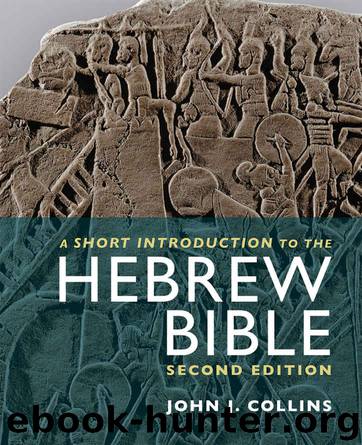A Short Introduction to the Hebrew Bible by John J. Collins

Author:John J. Collins [Collins, John J.]
Language: eng
Format: azw3
Publisher: Fortress Press
Published: 2014-07-31T16:00:00+00:00
The use of marriage as metaphor implies a covenantal relationship. It is clear that Hosea, like Amos, saw this relationship as conditional. It entailed certain ethical and cultic requirements. If Israel failed to comply, the relationship could be broken off. All of this corresponds to the understanding of the Mosaic covenant in Exodus and Deuteronomy. It is also clear that the people addressed by the prophets did not share that understanding. Instead of the analogy of international treaties, Hosea uses marriage as his guiding metaphor.
The marriage metaphor is developed at length in chapter 2. This long poetic oracle is presented as a legal indictment (Hebrew rîb). It is sometimes called a “covenant lawsuit,” but the metaphor is one of divorce proceedings rather than of treaty violation. The grounds for divorce are the wife’s adultery. In ancient Israel, only the husband could initiate divorce, and the view of adultery was usually one-sided, a point noted later by Hosea (4:14). The punishment for adultery here, “I will strip her naked,” is not attested elsewhere in the Hebrew Bible, except in Ezek 16:37-39, which may be influenced by Hosea (cf. also the story of Susanna 1:32). In biblical law the punishment for adultery is death by stoning (Deut 22:23-24; both Ezekiel and Susanna also envision an ultimate death penalty). In Genesis 38 Judah condemns Tamar to be burned. The punishment of stripping allows the prophet in Hosea 2 to speak metaphorically of the stripping of the land, to make it like a wilderness.
The adultery of Israel consisted of worshiping Baal, the Canaanite god, who was widely revered in the northern kingdom of Israel. Baal was attractive because he was a fertility deity, the “rider of the clouds” and bringer of rain. People believed that he provided “the grain, the wine, and the oil.” Hosea insists to the contrary that YHWH is the deity who provides these goods. (Compare the story of Elijah and the prophets of Baal).
Hosea differs from Amos in two crucial respects. First, the primary sin of which Israel is accused is Baal worship. Hosea is also concerned about social justice, but it plays a secondary role. Second, he vacillates between judgment and oracles of salvation. The wilderness was, on the one hand, a place of death and punishment. But it was also the place where Israel had encountered YHWH in the exodus tradition. Hosea recalls the wilderness period of the exodus as the courtship of YHWH and Israel. If Israel is again reduced to wilderness, this is also an opportunity for a new beginning. Israel would no longer address its god as “baal,” which meant “lord, husband” (but was also the name of the god), but as ’ishy, “my man/husband,” with a connotation of partnership rather than subordination. In effect, YHWH and Israel would renew their marriage.
The marriage metaphor for the relationship between God and Israel is not without its problems. The prophet takes the common assumptions about the roles of husband and wife as his point of departure. The adulterous wife could be humiliated and even put to death.
Download
This site does not store any files on its server. We only index and link to content provided by other sites. Please contact the content providers to delete copyright contents if any and email us, we'll remove relevant links or contents immediately.
| Hebrew Bible (Old Testament) | Talmud |
| Torah | Zohar |
Man's Search for Meaning by Viktor E. Frankl(2261)
The Secret Power of Speaking God's Word by Joyce Meyer(2255)
Mckeown, Greg - Essentialism: The Disciplined Pursuit of Less by Mckeown Greg(2115)
MOSES THE EGYPTIAN by Jan Assmann(1974)
Unbound by Arlene Stein(1944)
Devil, The by Almond Philip C(1903)
The Complete Dead Sea Scrolls in English (7th Edition) (Penguin Classics) by Geza Vermes(1844)
I Capture the Castle by Dodie Smith(1574)
Schindler's Ark by Thomas Keneally(1516)
The Invisible Wall by Harry Bernstein(1460)
The Gnostic Gospel of St. Thomas by Tau Malachi(1414)
The Bible Doesn't Say That by Dr. Joel M. Hoffman(1372)
The Secret Doctrine of the Kabbalah by Leonora Leet(1269)
The Jewish State by Theodor Herzl(1252)
The Book of Separation by Tova Mirvis(1225)
A History of the Jews by Max I. Dimont(1210)
The Dead Sea Scrolls Bible by Martin G. Abegg(1200)
Political Theology by Carl Schmitt(1189)
Oy!: The Ultimate Book of Jewish Jokes by David Minkoff(1105)
